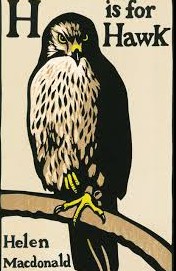Inspiring Older Readers
 posted on 31 Jul 2015
posted on 31 Jul 2015
H is for Hawk : Helen Macdonald’s story of personal tragedy, depression and obsession takes flight
This is a book of layers and all of them are fascinating. At first sight it looks like the author is documenting a love affair with birds of prey – in particular goshawks – and as such it is an intense adventure. But it is also a homage to the spirit of T. H. White (he of Sword in the Stone and The Once and Future King fame) who also wrote movingly of his time training these enigmatic hunting birds. However, these twin pillars are just the supports on which this book rests its key theme – the impact of grief, the development of clinical depression and the insidious impact it has on the world you live in.
Macdonald had grown up as a girl enchanted by two things – her father and birds – birds of prey in particular. When her father dies she is understandably devastated but fails to recognise the way the tragedy of loss has entered her soul. She finds her emotional moorings have been cut adrift but, as is true with so many people who have this illness, refuses to acknowledge the depths of despair she is plumbing. Without ever being able to see or articulate it she slides into clinical depression and in many ways the book is a description and an exploration of this state.
The first symptoms of her depressive state manifest themselves in forms of obsession – first with the idea of training a Goshawk and secondly with tracing the parallels between her and White’s classic study The Goshawk written in 1937. Tellingly, Macdonald sees White’s book for what it is, an exploration of the writers own monomania, without being able to see she too had set out on the same journey.
In beautiful and, at times, oppressive detail we follow Macdonald and her attempts to train the Goshawk (the most difficult bird of prey to train, apparently) as her fixated and obsessive behaviour begins to cut her off from the outside world – she loses her job, her friends and her perspective on life. Soon she starts to see herself in terms of the bird itself – assessing the world through its eyes and its supposed emotions.
Ultimately she is saved from the downward spiral of depression by a doctor able to see what’s happening to her and willing to prescribe a regime of medication that gets her back to some kind of even keel.
I guess it makes a sort of commercial sense to market this book as an exploration of falconry or hawking (or whatever the real technical term is for training birds of prey) rather than as a book about depression. But this in itself tells you something about the stigma of mental illness and the way the issue is perceived. The book should be lauded for the unflinching way it shows how depression can seize your life, turning you into someone you never intended to be. If you want an accessible way to experience the inner turmoil of grief and depression without being lectured about it – this is a good place to start.
Terry Potter